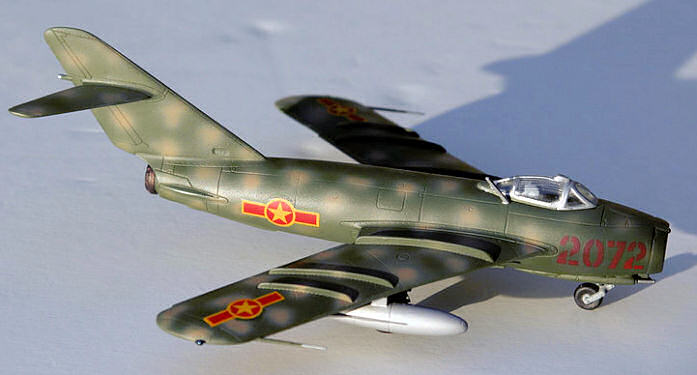
DML 1/72 Jian Ji-5 (MiG-17F)
| KIT #: | 2513 |
| PRICE: | $ Currently out of production |
| DECALS: | Five options |
| REVIEWER: | Kevin Thompson |
| NOTES: | First in a series of North Vietnamese MiGs |

| HISTORY |
Not long after the MiG-15 went into production, work was already underway on its successor. The design team of Artyom Mikoyan and Mikhail Gurevich decided on using the general layout and some of the components of the existing fighter, while incorporating some major improvements. The new aircraft featured a larger, all-new wing with a higher leading edge sweep angle of 49 degrees at mid-span, and 45.5 degrees to tip (compared to the MiG-15’s 35 degree sweep). Fuselage was substantially lengthened, and aircraft fitted with an improved VK-1A engine with 5,952 pounds of thrust.
The prototype, designated I-330, first flew on January 13, 1950. Production aircraft were designated MiG-17 (NATO code-name “Fresco-A”), and were produced in satellite countries as well as the Soviet Union including China, Czechoslovakia and Poland. The MiG-17 was the first Soviet fighter to exceed Mach 1, although this was achieved in a shallow dive and not in level flight. An improved, afterburning VK-1F engine of over 7,200 pounds of thrust became available after short production of the initial Fresco-A and -B models, and production was underway of the MiG-17F (“F” for the Russian word “forsirovannyi” or “boosted”, indicating the afterburner).
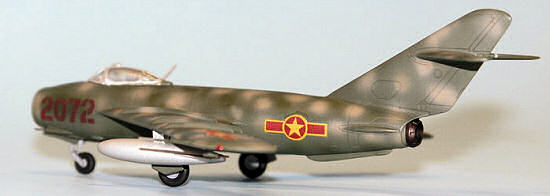 The
MiG-17F (known to NATO as “Fresco-C”) became the definitive version of this
aircraft, with examples built in China as the JI 5 or F-5, Czechoslovakia, and
in Poland as the Lim-5 and Lim-6. Over 9,000 MiG-17s of all variants were
produced, before production ceased in favor of newer designs. In the hands of an
experienced pilot, the MiG-17F was a lethal and effective fighter aircraft, due
to its excellent thrust-to-weight ratio, outstanding maneuverability, and potent
armament of two 23mm and one 37mm cannon. MiG-17s were used by Egypt and Syria
in various Middle East conflicts, and were used extensively by the Vietnamese
People’s Air Force (VPAF, North Vietnam) in Southeast Asia against the U.S. from
1965 to 1973.
The
MiG-17F (known to NATO as “Fresco-C”) became the definitive version of this
aircraft, with examples built in China as the JI 5 or F-5, Czechoslovakia, and
in Poland as the Lim-5 and Lim-6. Over 9,000 MiG-17s of all variants were
produced, before production ceased in favor of newer designs. In the hands of an
experienced pilot, the MiG-17F was a lethal and effective fighter aircraft, due
to its excellent thrust-to-weight ratio, outstanding maneuverability, and potent
armament of two 23mm and one 37mm cannon. MiG-17s were used by Egypt and Syria
in various Middle East conflicts, and were used extensively by the Vietnamese
People’s Air Force (VPAF, North Vietnam) in Southeast Asia against the U.S. from
1965 to 1973.
As the war in Southeast Asia began to escalate, communist North Vietnam began to receive a steady supply of weaponry from both the Soviet Union and China. In August 1964 the VPAF received its first 36 MiG-17s from the Soviet Union, these being the “Fresco-A” version. This first batch of aircraft was assigned to the 921st Fighter Regiment based at Noi Bai, north west of Hanoi. During the entire conflict with the U.S., the VPAF received roughly 200 MiG-17s, MiG-17Fs, MiG-17PFs and Chinese built F-5s.
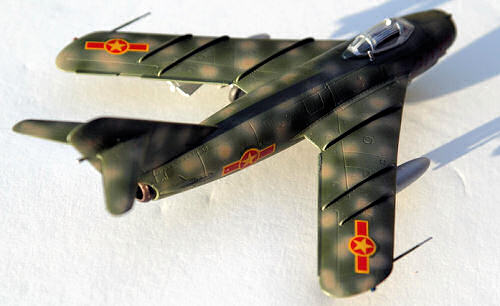 The
1950s-vintage aircraft made good account of itself against a numerically and
technologically superior United States Navy and Air Force, utilizing its
excellent maneuverability and potent cannon armament. The 921st and
923rd Air Regiments were the two units equipped with the MiG-17. The
VPAF claims to have shot down at least 71 U.S. aircraft during the Air War years
1965-1972 with MiG-17s alone. These include the F-8 Crusader, F-105
Thunderchief, F-4 Phantom II, A-1E Skyraider, Firebee
Drone, RC-47, and at least one CH-3C helicopter. Three pilots, Le Hai, Nguyen
Van Bay and Luu Huy Chao, all of the 923rd Fighter Regiment, became
aces while flying the MiG-17. The VPAF took its licks, however. Several MiG-17s
were lost to US Aircraft, friendly fire, accidents and general attrition in an
extreme climate of intense heat and humidity. By the end of 1972, the VPAF
MiG-17 force was severely battered, many of the rough-duty aircraft in need of
extensive maintenance and repair, and some quite simply beyond that point. The
VPAF used the aging MiG-17 “Fresco” alongside the newer, Mach 2 MiG-21 “Fishbed”,
serving gallantly in primitive and harsh conditions in an aerial struggle
lasting nearly a decade.
The
1950s-vintage aircraft made good account of itself against a numerically and
technologically superior United States Navy and Air Force, utilizing its
excellent maneuverability and potent cannon armament. The 921st and
923rd Air Regiments were the two units equipped with the MiG-17. The
VPAF claims to have shot down at least 71 U.S. aircraft during the Air War years
1965-1972 with MiG-17s alone. These include the F-8 Crusader, F-105
Thunderchief, F-4 Phantom II, A-1E Skyraider, Firebee
Drone, RC-47, and at least one CH-3C helicopter. Three pilots, Le Hai, Nguyen
Van Bay and Luu Huy Chao, all of the 923rd Fighter Regiment, became
aces while flying the MiG-17. The VPAF took its licks, however. Several MiG-17s
were lost to US Aircraft, friendly fire, accidents and general attrition in an
extreme climate of intense heat and humidity. By the end of 1972, the VPAF
MiG-17 force was severely battered, many of the rough-duty aircraft in need of
extensive maintenance and repair, and some quite simply beyond that point. The
VPAF used the aging MiG-17 “Fresco” alongside the newer, Mach 2 MiG-21 “Fishbed”,
serving gallantly in primitive and harsh conditions in an aerial struggle
lasting nearly a decade.
| THE KIT |
Dragon Models Limited, DML, released several 1/72 kits of both the MiG-15 and MiG-17 in the early-90s. Kit number 2512, “MiG-17 Fresco” is the early, non-afterburning version, and our subject, number 2513, is listed as the Jian Ji 5, and is the MiG-17F with afterburner. Both kits are identical, except for the aft fuselage section (with early or late air brakes, depending on version) and exhaust tailpipe. The earlier kit, 2512, is now re-boxed by the Czech company Bilek as kit number 965 with a great decal sheet by Tally Ho. Be warned, however, that this Bilek box says “MiG-17F”, but the kit inside is in fact the non-afterburning MiG-17 “Fresco-A”.
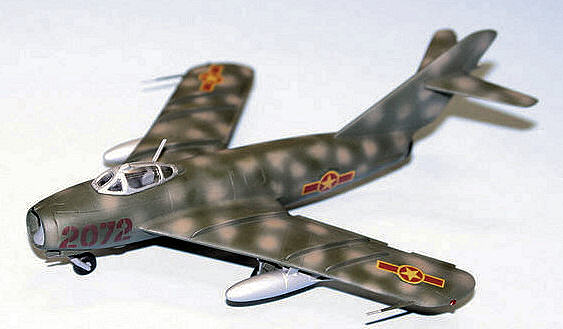 Kit
contains 50 parts, and has good detail throughout. It has crisp, clean molding
with little to no flash, and excellent engraved panel lines. The overall
thickness of flying surfaces is on the money for 1/72 scale, particularly the
leading and trailing wing edges. The overall shape, proportions and accuracy are
correct. This kit does a couple of things very well. The first thing is to be
the best 1/72 MiG-17 there is, completely blowing away the older Hasegawa and KP
kits. The second is to really show just how small the MiG-17 is. The 60s-vintage
Hasegawa kit (radar-equipped PFU) looked OK from a distance, but had several
inaccuracies, including, above all, scale. It was probably the only “1/68”
MiG-17 kit out there!
Kit
contains 50 parts, and has good detail throughout. It has crisp, clean molding
with little to no flash, and excellent engraved panel lines. The overall
thickness of flying surfaces is on the money for 1/72 scale, particularly the
leading and trailing wing edges. The overall shape, proportions and accuracy are
correct. This kit does a couple of things very well. The first thing is to be
the best 1/72 MiG-17 there is, completely blowing away the older Hasegawa and KP
kits. The second is to really show just how small the MiG-17 is. The 60s-vintage
Hasegawa kit (radar-equipped PFU) looked OK from a distance, but had several
inaccuracies, including, above all, scale. It was probably the only “1/68”
MiG-17 kit out there!
The KP MiG-17PF was closer to scale, but is inaccurate in all the flying surfaces, particularly the wing shape and size of the horizontal stabilizers. It baffles me that in Czechoslovakia, where several of these full-size aircraft were available for inspection and measurement, a better kit was not produced. After all, some of KP’s earlier kits, including the MiG-19, were more accurate.
Getting back to the DML kit, it is also the first and only injection-molded “non radar-equipped” Fresco in 1/72 scale. The two-piece canopy is even molded with overhead defroster grid; not an easy task in this small a scale. Decals cover five different aircraft, including China, Czechoslovakia, Poland, Syria and Vietnam, but are a bit pale in color. Aftermarket and alternate kit decals will be used for this very basic Vietnamese scheme. In any case, the kit has the right amount of detail, and looks to be a fun and easy build.
| CONSTRUCTION |
Starting with the cockpit, consisting of the tub itself, a 3-piece ejection seat, stick and instrument panel, everything was painted Testors Model Master FS 36270 neutral gray, with details on the instrument panel and stick done in flat black and silver. I am not a big cockpit detail guy; if a kit has a simple, 5-piece cockpit, I am OK with that. On the other hand, if a kit has a well-detailed cockpit, as in many of the 1/48 kits out there these days, I will detail it out to the full extent of the stock kit parts. It is not a big priority for me to have PE seat belts, etc.
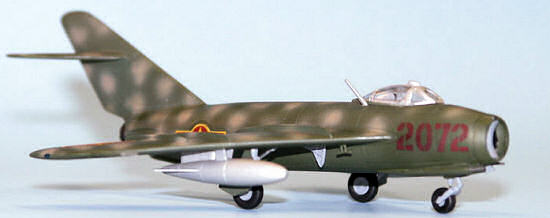 After
gluing completed cockpit tub assembly to right fuselage half, it was time to put
some weight in the nose. Only noted problem with this kit is that the lower
front fuselage (gun section and nose gear bay) intrudes into and is visible in
front intake section, at lower part of splitter. To “kill two birds with one
stone”, nose weight was installed just ahead of cockpit, then a piece of
Plastruct sheet was cut in a circular disc matching forward fuselage inside
diameter, and installed just aft of splitter. I painted it flat black, to give
it a look of depth behind the splitter. I then trimmed the front of the nose
gear bay to fit behind the Plastruct disc, and fitted the gun and nose gear bay
assembly to the main fuselage.
After
gluing completed cockpit tub assembly to right fuselage half, it was time to put
some weight in the nose. Only noted problem with this kit is that the lower
front fuselage (gun section and nose gear bay) intrudes into and is visible in
front intake section, at lower part of splitter. To “kill two birds with one
stone”, nose weight was installed just ahead of cockpit, then a piece of
Plastruct sheet was cut in a circular disc matching forward fuselage inside
diameter, and installed just aft of splitter. I painted it flat black, to give
it a look of depth behind the splitter. I then trimmed the front of the nose
gear bay to fit behind the Plastruct disc, and fitted the gun and nose gear bay
assembly to the main fuselage.
As previously mentioned, this kit was made in two different versions, and to accommodate this, the rear fuselage section is separate from the forward fuselage section, somewhat like a larger kit with viewable engine and removable tail section, as on the real aircraft. Because this kit does not have engine detail, the rear halves were glued to the front section, then the vertical fin and rudder installed. Wings and horizontal tail feathers came next, all true-sighted head-on. MiG-17 has slight wing anhedral, and the fit at wing roots is very good.
Once the main airframe assembly was completed and dried, gentle sanding followed by wet sanding with 400, then 1000 brought all seams closed. The fit of this kit is very good overall, and no filler was needed. Once the sanding was completed, main gear legs and struts were installed, as were the wing antennae, inboard main gear doors at wing root, nose gear doors, and cannon. Wherever possible, landing gear legs are attached to the model before painting, to insure a stronger joint. Now the MiG was ready for paint.
| COLORS & MARKINGS |
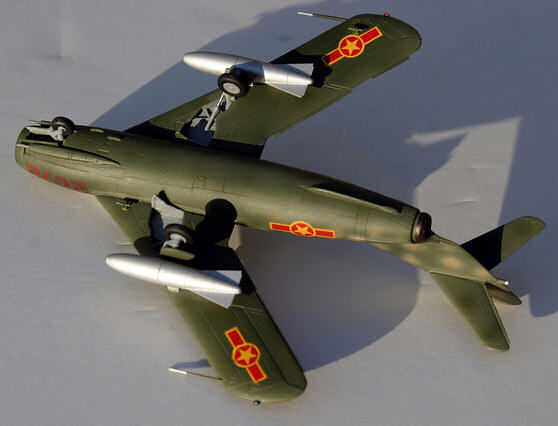 Using the
excellent Osprey Publication, “MiG-17 and MiG-19 Units of the Vietnam War” by
Istvan Toperczer as a guide, a camouflaged MiG-17F from the 921st
Fighter Regiment was chosen. VPAF MiG-17s were predominately natural metal, and
a few were painted in medium gray. From 1968, however, U.S. air raids were
becoming more common, and several of the VPAF MiGs were hastily painted in dark
green cammo schemes in attempt to better conceal themselves beneath trees and
foliage. Some were two-tone green, and some others had tan or khaki in the mix,
and no two were alike! I chose aircraft number 2072, featuring a two-tone green
scheme with tan spots. This scheme looks a bit WWII Japanese or Italian. The
entire airframe was first sprayed with Testors Model Master II 2027 Dark Green
(B-52), FS 34096. Then a random, scattered spotting of the second green, Model
Master 1713 FS 34102 was applied. It is possible that these MiGs were painted
green overall, or that the wing undersides were left natural aluminum. This is
still under investigation, so I chose to paint wing undersides in the same
green. Once this had dried, the tan spots were applied to the upper surface
using a 50/50 mixture of Model Master II 2110 Italian Sand and Model Master 1706
FS 33531 Sand. Once the paint had dried overnight, a coat of clear gloss was
applied to aid in decal adhesion.
Using the
excellent Osprey Publication, “MiG-17 and MiG-19 Units of the Vietnam War” by
Istvan Toperczer as a guide, a camouflaged MiG-17F from the 921st
Fighter Regiment was chosen. VPAF MiG-17s were predominately natural metal, and
a few were painted in medium gray. From 1968, however, U.S. air raids were
becoming more common, and several of the VPAF MiGs were hastily painted in dark
green cammo schemes in attempt to better conceal themselves beneath trees and
foliage. Some were two-tone green, and some others had tan or khaki in the mix,
and no two were alike! I chose aircraft number 2072, featuring a two-tone green
scheme with tan spots. This scheme looks a bit WWII Japanese or Italian. The
entire airframe was first sprayed with Testors Model Master II 2027 Dark Green
(B-52), FS 34096. Then a random, scattered spotting of the second green, Model
Master 1713 FS 34102 was applied. It is possible that these MiGs were painted
green overall, or that the wing undersides were left natural aluminum. This is
still under investigation, so I chose to paint wing undersides in the same
green. Once this had dried, the tan spots were applied to the upper surface
using a 50/50 mixture of Model Master II 2110 Italian Sand and Model Master 1706
FS 33531 Sand. Once the paint had dried overnight, a coat of clear gloss was
applied to aid in decal adhesion.
The VPAF
insignia (a “star and bar” which in shape and style looks a lot like the US
insignia, in completely different colors, of course) was not uniformly
proportioned on all aircraft. The bars were in different sizes in relation to
the star and circle from plane to plane, and MiG-17s had insignia in different
sizes. A good photo of 2072 in the front of Dr. Toperczer’s book shows that this
aircraft had smaller insignia. At the time, I had no good examples of the
insignia in 1/72, so I opted to use the VPAF insignia from
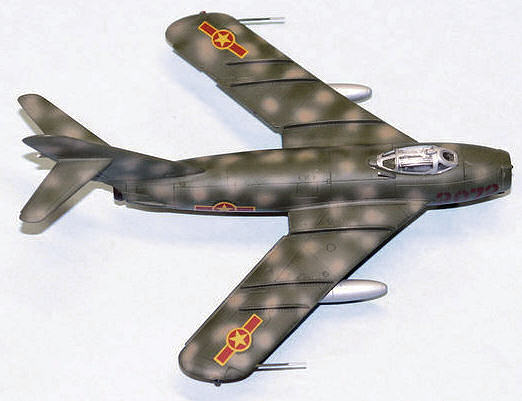 the 1/48 Academy
MiG-21 decal sheet. Sizing is just right. VPAF aircraft all had tactical numbers
stenciled in red on the front fuselage sides. Mark Borer made the number decals
on an ALPS printer. Mark made VPAF numbers and insignia in 1/72, 1/48 and 1/32
scale for all future projects, and did an outstanding job. Once decals were
applied and Micro Sol used, two coats of Testors Dull Coat were applied.
Remember that VPAF aircraft were all subject to rough duty, and none were
pretty!
the 1/48 Academy
MiG-21 decal sheet. Sizing is just right. VPAF aircraft all had tactical numbers
stenciled in red on the front fuselage sides. Mark Borer made the number decals
on an ALPS printer. Mark made VPAF numbers and insignia in 1/72, 1/48 and 1/32
scale for all future projects, and did an outstanding job. Once decals were
applied and Micro Sol used, two coats of Testors Dull Coat were applied.
Remember that VPAF aircraft were all subject to rough duty, and none were
pretty!
On the actual aircraft, the camouflage was applied very hastily, so often the canopy frame was left unpainted on many of the VPAF MiGs. I used Model Master Aluminum Non-Buffing Metalizer for the canopy frame as well as the drop tanks, which were either natural metal or camouflaged, depending on how many sets of tanks were used since the camouflage was applied. Intake splitter was done in FS 36375 Light Ghost Gray. Wheel wells, gear struts, inside of gear doors and wheel hubs painted in Neutral Gray FS 36270. Strut details, pitot tube tips and fuselage antenna mast all done in silver or aluminum. Afterburner tailpipe was painted with Testors Burnt Iron Metalizer, as were cannon barrels.
| FINAL CONSTRUCTION |
Straightforward assembly of landing gear wheels and gear doors, except that there is more room to install the main gear doors if the drop tanks are fitted after the gear is completed. This was found out after the fact, but a steady hand and some tweezers got those main gear doors in place without too much fuss. Canopy installed with white Elmer’s glue. This was the last step in construction.
| CONCLUSIONS |
 The
MiG-17 is a historically significant jet fighter. Over 9000 were built, and it
was used by dozens of Soviet-friendly countries, from Cuba to China, and had its
greatest combat success in Vietnam. While it is surprising that there aren’t
more kits of this aircraft, this DML release has absolutely “nailed it” on
accuracy. The kit has no flaws to speak of, and is straightforward in
construction, the only thing to watch being nose weight and the front gear and
gun bay intruding on the intake. There are many aftermarket decals available for
this little guy, and if you are a MiG fan like I am, choose your favorite paint
and markings and build one of these for yourself. I highly recommend it. This
kit is very rewarding, but it may take a little effort to find, now that it is
out of production.
The
MiG-17 is a historically significant jet fighter. Over 9000 were built, and it
was used by dozens of Soviet-friendly countries, from Cuba to China, and had its
greatest combat success in Vietnam. While it is surprising that there aren’t
more kits of this aircraft, this DML release has absolutely “nailed it” on
accuracy. The kit has no flaws to speak of, and is straightforward in
construction, the only thing to watch being nose weight and the front gear and
gun bay intruding on the intake. There are many aftermarket decals available for
this little guy, and if you are a MiG fan like I am, choose your favorite paint
and markings and build one of these for yourself. I highly recommend it. This
kit is very rewarding, but it may take a little effort to find, now that it is
out of production.
| REFERENCES |
Osprey Combat Aircraft number 25, MiG-17 and MiG-19 Units Of The Vietnam War, by Istvan Toperczer. 2001 Osprey Publishing Limited.
Koku-Fan The North Vietnam Forces In The S.E.A. War, 1973 Bunrin-Do Publishing Co.
August 2006
Copyright ModelingMadness.com
If you would like your product reviewed fairly and fairly quickly, please contact the editor or see other details in the Note to Contributors.